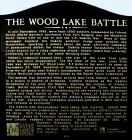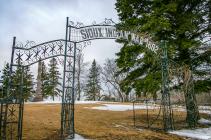Inscription
THE WOOD LAKE BATTLE
In mid-September, 1862, more than 1,600 soldiers commanded by Colonel Henry Sibley marched northwest from Fort Ridgely into the Minnesota River Valley with an aim to end the U.S.-Dakota War. Word of that movement reached the Dakota soldiers' lodge near present-day Montevideo, sparking a debate about the most effective campaign to permanently defeat the enemy. Dakota leader Taoyateduta (Little Crow) argued for a risky nighttime attack; others called that cowardly, preferring to attack in the early morning hours.
Sibley's command camped here, the site of the Lone Tree Lake which has since disappeared. (At the time of the war, Lone Tree Lake was mistaken for Wood Lake, 3.5 miles to the west.) At dawn on September 23, 1862, hundreds of Dakota warriors prepared to attack from the tall grass near Sibley's encampment, three miles south of the Yellow Medicine Agency, known today as the Upper Sioux Community.
The ambush was thwarted when several men from Sibley's camp left in a wagon in search of potatoes. Gunfire erupted as the wagons threatened to run over the Dakota, alerting the soldiers at Sibley's camp. Battle-hardened Civil War veterans of the Third Minnesota Infantry sprang into action, bolstering the raw recruits and volunteers during this final battle of the war. Two hours of fighting on the 600-acre-site brought victory for Sibley's command and put an end to the war. Taoyateduta retreated westward with 200 to 300 warriors who refused to surrender.
The Dakota who surrendered were taken into custody; almost 400 men, including non-combatants, were hastily tried by military tribunal. Of those, 303 Dakota men were found guilty and sentenced to hanging. Aides to President Abraham Lincoln reviewed the records, and Lincoln reduced the sentences. On December 26, 1862, in Mankato, Minnesota, 38 men were sentenced to hang in what became the largest mass execution in U.S. history.
Minnesota Historical Society
2012
Details
| HM Number | HM1B4K |
|---|---|
| Series | This marker is part of the Minnesota Historical Society series |
| Tags | |
| Historical Period | 19th Century |
| Historical Place | Battlefield |
| Marker Type | Other |
| Marker Class | Historical Marker |
| Marker Style | Free Standing |
| Year Placed | 2012 |
| Placed By | Minnesota Historical Society |
| Marker Condition | No reports yet |
| Date Added | Saturday, October 11th, 2014 at 3:57am PDT -07:00 |
Pictures
Photo Credits: [1] MARTHA DECKER [2] MARTHA DECKER [3] MARTHA DECKER
Locationbig map
| UTM (WGS84 Datum) | 15T E 307033 N 4952681 |
|---|---|
| Decimal Degrees | 44.70153333, -95.43571667 |
| Degrees and Decimal Minutes | N 44° 42.092', W 95° 26.143' |
| Degrees, Minutes and Seconds | 44° 42' 5.5200" N, 95° 26' 8.5800" W |
| Driving Directions | Google Maps |
| Area Code(s) | 507 |
| Can be seen from road? | Yes |
| Is marker in the median? | No |
| Which side of the road? | Marker is on the right when traveling East |
| Closest Postal Address | At or near 6031-6097 Co Hwy 18, Echo MN 56237, US |
| Alternative Maps | Google Maps, MapQuest, Bing Maps, Yahoo Maps, MSR Maps, OpenCycleMap, MyTopo Maps, OpenStreetMap |
Is this marker missing? Are the coordinates wrong? Do you have additional information that you would like to share with us? If so, check in.
Nearby Markersshow on map
Show me all markers in: Echo, MN | Yellow Medicine County | 56237 | Minnesota | United States of America



Comments 0 comments